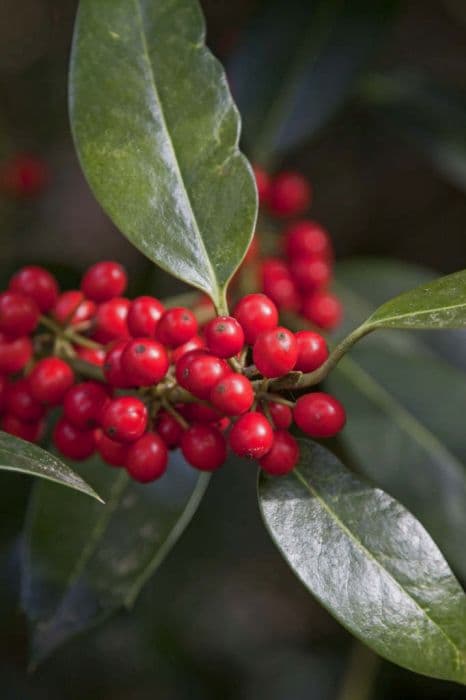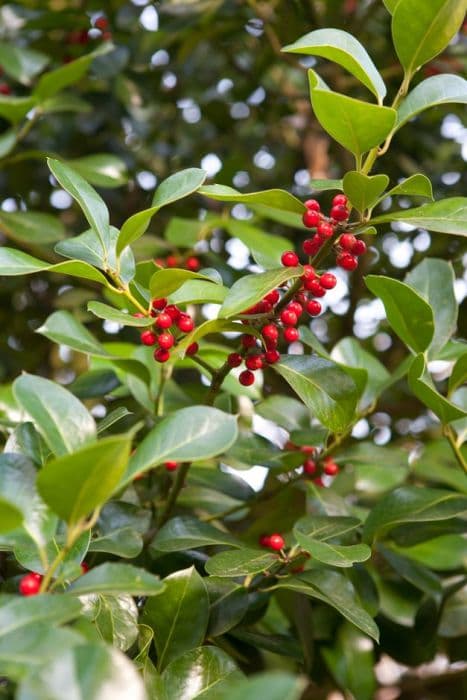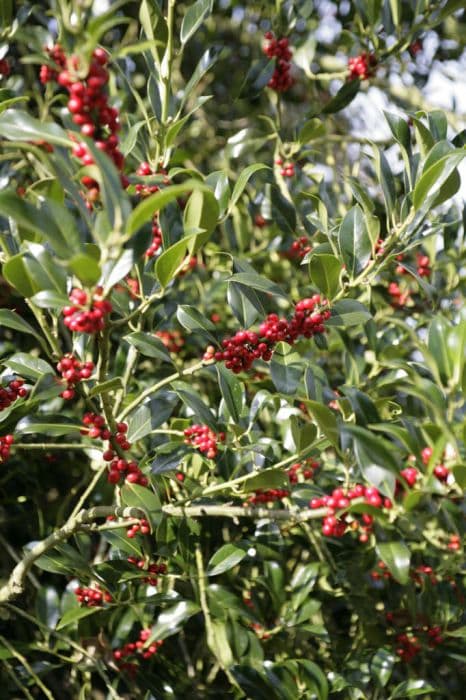Golden Queen Holly Ilex aquifolium 'Golden Queen' (m/v)

ABOUT
The 'Golden Queen' is a variety of the common holly known for its striking foliage and ornamental value. This plant boasts glossy leaves that are edged with an eye-catching golden-yellow color, creating a beautiful contrast with the darker green hues in the center. The leaves are characteristically spiny, with several pointed tips on each leaf which is reminiscent of traditional holly. During the cooler months, the 'Golden Queen' produces vivid red berries that are particularly prominent against the variegated leaves, adding to its festive appeal. These berries also provide a valuable food source for birds during the winter. Overall, the 'Golden Queen' holly is a visually striking plant with a combination of variegated foliage and bright berries, making it a popular choice for gardeners looking to add year-round interest to their gardens.
About this plant
 Names
NamesFamily
Aquifoliaceae.
Synonyms
English Holly, European Holly, Christmas Holly, Golden Queen Holly.
Common names
Ilex aquifolium 'Aurea Regina'
 Toxicity
ToxicityTo humans
The English Holly is considered to be toxic to humans. The toxicity mainly resides in the berries and to a lesser extent in the leaves. If ingested, symptoms of poisoning can include nausea, vomiting, diarrhea, and abdominal pain. In severe cases, ingestion can lead to drowsiness, dehydration, and in very rare cases, it might be fatal if consumed in large quantities. Care should be taken to prevent the ingestion of parts of the plant, particularly by children who might be attracted to the bright berries.
To pets
English Holly is also toxic to pets, including dogs and cats. The toxic elements are found primarily in the berries, but the leaves can also cause problems. Symptoms of poisoning in pets may include vomiting, diarrhea, decreased appetite, and lethargy. If larger amounts are consumed, more severe symptoms such as tremors or seizures could occur. Pet owners should ensure that their animals do not have access to the berries or leaves of this plant.
 Characteristics
CharacteristicsLife cycle
Perennials
Foliage type
Evergreen
Color of leaves
Variegated
Flower color
White
Height
6-10 feet (1.8-3 meters)
Spread
5-8 feet (1.5-2.4 meters)
Plant type
Shrub
Hardiness zones
5-9
Native area
Europe
Benefits
 General Benefits
General Benefits- Aesthetic Appeal: Adds vibrant color with its variegated leaves that have golden-yellow margins complementing the dark green center.
- Habitat Support: Provides shelter and a food source for birds, offering a supply of berries especially beneficial during winter months.
- Privacy Screening: Can be used in hedges or as a screening plant to create private spaces due to its dense foliage.
- Year-Round Interest: Evergreen nature ensures that it contributes to the garden landscape throughout the seasons.
- Tolerance to Shade: Grows well in both full sun and partial shade, making it versatile for different garden locations.
- Low Maintenance: Requires minimal care once established, making it suitable for gardeners of all skill levels.
- Drought Resistance: Once established, has the ability to withstand periods of low water availability.
- Soil Adaptability: Adaptable to a range of soil types, though it prefers well-drained, slightly acidic soil.
- Formal Gardening: Ideal for formal garden designs, including topiaries and parterres, due to its structured growth habit.
- Wildlife Attraction: The berries attract various species of birds, while the dense foliage offers nesting sites.
- Seasonal Berries: Produces red berries that add a splash of color to the garden in autumn and winter, providing seasonal interest.
- Cultural Significance: Recognized as a traditional symbol of Christmas and used for holiday decorations.
 Medical Properties
Medical Properties- Diuretic: Some parts of the Holly (the common name of Ilex aquifolium) may have been historically used for their diuretic effects to help with fluid retention.
- Anti-inflammatory: Holly leaves might have been used traditionally to reduce inflammation, although there's limited evidence to support this use.
 Air-purifying Qualities
Air-purifying QualitiesThis plant is not specifically known for air purifying qualities.
 Other Uses
Other Uses- Photography Backdrop: The bright variegated leaves of the 'Golden Queen' Holly can provide a striking background for macro or close-up photography, particularly in the autumn and winter months when the contrast with red berries is pronounced.
- Christmas Decorations: The variegated leaves and bright red berries of the Holly 'Golden Queen' are often used in Christmas wreaths, table arrangements, and other festive decorations due to their traditional holiday appearance.
- Privacy Screens: With its dense growth habit, the 'Golden Queen' Holly can be used to create living privacy screens or hedges in the garden, offering year-round privacy and interest.
- Culinary Garnish: While the berries are not edible, the distinct leaves of the 'Golden Queen' Holly can be used to add visual appeal to culinary dishes as a non-toxic garnish during the holiday season.
- Wildlife Shelter: The dense foliage of the 'Golden Queen' Holly provides excellent shelter for birds and other wildlife, especially during the harsh winter months when shelter is scarce.
- Bonsai: 'Golden Queen' can be trained as a bonsai, with its small leaves and berries making an interesting and colorful miniature tree for enthusiasts.
- Teaching Aid: The distinct leaf shape and variation of 'Golden Queen' Holly is used for educational purposes in botany and horticulture classes to teach about plant variegation and leaf morphology.
- Ink Production: Historically, the tannins found in the bark of Holly plants have been used in ink production, and though more of a traditional craft, it could be an interesting use for creative art projects.
- Woodworking: Holly wood is fine-grained and can be used for making small wooden items such as chess pieces, inlays, and scrollsaw art.
- Folklore and Tradition: Holly, including the 'Golden Queen', plays a significant role in winter folklore and can be used in cultural studies or thematic educational settings exploring these traditions.
Interesting Facts
 Feng Shui
Feng ShuiThe English Holly is not used in Feng Shui practice.
 Zodiac Sign Compitability
Zodiac Sign CompitabilityThe English Holly is not used in astrology practice.
 Plant Symbolism
Plant Symbolism- Protection: Ilex aquifolium, commonly known as Holly, is often associated with protection due to its spiky leaves, which were believed to ward off evil spirits and negative energies.
- Eternal Life: Holly is an evergreen plant, symbolizing immortality and the idea of life continuing despite harsh conditions, often linked to the eternal aspect of human spirit.
- Good Fortune: The 'Golden Queen' variety, with its golden-edged leaves, may be seen as a symbol of prosperity and wealth, possibly due to the association of gold with good fortune.
- Hope: Holly is commonly used in Christmas decorations, representing hope and the anticipation of spring during the darkest time of the year.
- Foresight: In ancient times, Holly was believed to possess magical properties, including the power to enhance foresight and protect against unforeseen events.
 Water
WaterThe Golden Queen Holly should be watered thoroughly whenever the top inch of soil feels dry to the touch. In general, this may mean watering every week during active growth periods in spring and summer, and less frequently, perhaps every two to three weeks, during the dormant period in fall and winter. It's critical to avoid waterlogging, so ensure that the plant has well-draining soil. Depending on the size of the plant and environmental conditions, a young Golden Queen Holly in a garden may need 1-2 gallons of water, while mature plants will need more.
 Light
LightThe Golden Queen Holly prefers full sun to partial shade. It thrives in a spot that receives direct sunlight for at least four to six hours a day. However, in regions with very hot summers, it benefits from some afternoon shade to protect it from intense, scorching sun.
 Temperature
TemperatureThe Golden Queen Holly is hardy and can tolerate a wide range of temperatures; however, it prefers to grow in conditions between 50°F to 70°F. This plant can survive minimum winter temperatures down to about -10°F and maximum summer temperatures as high as 90°F. Ideal growing conditions would prevent it from being exposed to temperatures outside this range for prolonged periods.
 Pruning
PruningPruning Golden Queen Holly is important to maintain its shape and encourage bushy growth. Prune in late winter or early spring before new growth begins. It's best to prune selectively, cutting back just above a leaf node to encourage branching. Remove any dead or damaged branches at the same time. Prune annually or as needed to shape the plant and keep it healthy.
 Cleaning
CleaningAs needed
 Soil
SoilThe Golden Queen Holly prefers fertile, well-drained soil with a slightly acidic pH between 5.0 and 6.0. A good soil mix can be made from one-third garden soil, one-third peat moss or compost, and one-third perlite or sand to improve drainage.
 Repotting
RepottingGolden Queen Holly, being slow-growing, does not require frequent repotting. Repot young plants every 2 to 3 years; mature specimens every 4 to 5 years or as needed when roots become pot-bound.
 Humidity & Misting
Humidity & MistingGolden Queen Holly thrives best in moderate to high humidity levels but is flexible and can adapt to lower humidity conditions as long as the soil moisture is adequate.
 Suitable locations
Suitable locationsIndoor
Ensure bright indirect light, keep soil moist.
Outdoor
Plant in well-drained soil; partial to full sun.
Hardiness zone
6-9 USDA
 Life cycle
Life cycleIlex aquifolium 'Golden Queen', commonly known as the Golden Queen English Holly, commences its life as a seed, often spread by birds that eat the berries and disperse the seeds through their droppings. Upon germinating, a seedling emerges and over several years develops into a juvenile plant, which is characterized by a rapid growth rate and the gradual appearance of the signature spiny, dark green leaves with golden-yellow edges. The juvenile phase can last for several years before the plant reaches maturity. In the mature phase, the Golden Queen English Holly becomes capable of flowering and subsequently producing its characteristic red berries, which only appear on female plants if a male pollinator is nearby, as the species is dioecious. Throughout its adult life, the holly undergoes periodic growth spurts each spring and summer, followed by periods of dormancy in the fall and winter. The shrub can live for many decades, with some specimens surviving for several hundred years, continuing to grow, flower, and produce berries provided it has favorable growing conditions.
 Propogation
PropogationPropogation time
Spring-Early Summer
One popular method to propagate Ilex aquifolium 'Golden Queen', commonly known as the variegated English holly, is through semi-hardwood cuttings. This process usually takes place in late summer to early fall. To do this, cut a 6 to 8 inch (15 to 20 cm) long stem segment with several leaves, removing the lower leaves to expose the nodes. The cut end is then dipped in rooting hormone to encourage root growth and inserted into a pot filled with a mixture of peat and perlite or sand to provide good drainage and aeration. The cutting should be kept moist and in indirect sunlight until roots develop, which can take several weeks. Once rooted, the cutting can be transplanted to a larger pot or directly into the garden.









